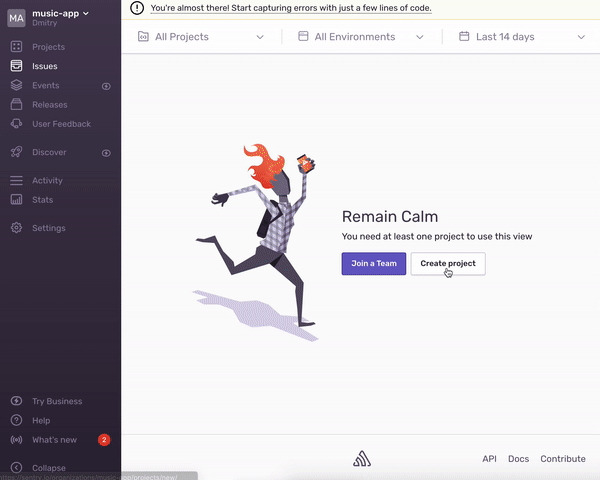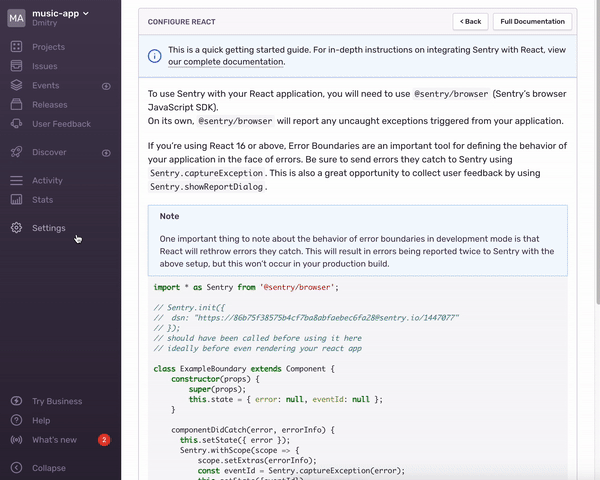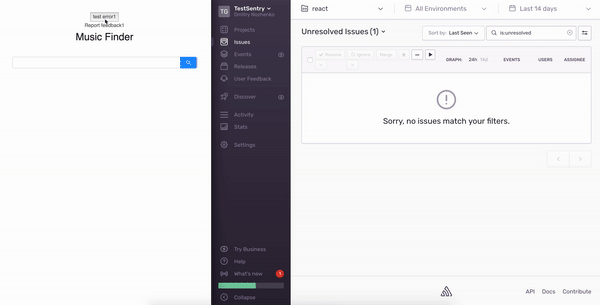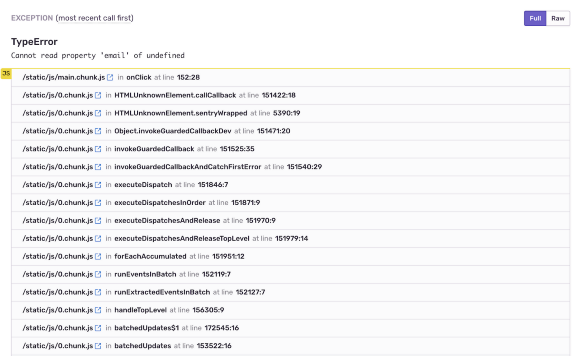
Hoje, vou orientá-lo no rastreamento de erros em tempo real em um aplicativo React. Um aplicativo front-end não é normalmente usado para rastreamento de bugs. Algumas empresas costumam adiar o rastreamento de bugs retornando a ele após a documentação, testes e muito mais. No entanto, se você pode mudar seu produto para melhor, basta fazê-lo!
1. Por que você precisa do Sentry?
Presumo que você esteja interessado em rastrear bugs durante a produção
Você acha que isso não é suficiente?
Ok, vamos ver os detalhes.
Principais motivos para usar o Sentry para desenvolvedores:
- Elimina o risco de implantação de código com bugs
- Assistência de QA no teste de código
- Receba notificações rápidas de problemas
- A capacidade de corrigir erros rapidamente
- Obter uma exibição conveniente dos erros no painel de administração
- Erros de classificação por segmento de usuário / navegador
As principais razões para o CEO / líder do projeto
- Economizando dinheiro (Sentry pode ser instalado em seus servidores)
- Obter feedback do usuário
- Compreensão em tempo real do que há de errado com seu projeto
- Compreender o número de problemas que as pessoas têm com seu aplicativo
- Ajude a encontrar lugares onde seus desenvolvedores cometeram um erro
, . , Sentry.
.
?

Sentry?
Sentry – , , . , . Sentry JavaScript, Node, Python, PHP, Ruby, Java .

2.
- Sentry . , . ( Sentry )
- . ( React. « »)

. , Sentry , :
import * as Sentry from '@sentry/browser';
// Sentry.init({
// dsn: "<https://63bbb258ca4346139ee533576e17ac46@sentry.io/1432138>"
// });
// should have been called before using it here
// ideally before even rendering your react app
class ExampleBoundary extends Component {
constructor(props) {
super(props);
this.state = { error: null };
}
componentDidCatch(error, errorInfo) {
this.setState({ error });
Sentry.withScope(scope => {
Object.keys(errorInfo).forEach(key => {
scope.setExtra(key, errorInfo[key]);
});
Sentry.captureException(error);
});
}
render() {
if (this.state.error) {
//render fallback UI
return (
<a onClick={() => Sentry.showReportDialog()}>Report feedback</a>
);
} else {
//when there's not an error, render children untouched
return this.props.children;
}
}
}Sentry , , . . , . , !
3. React Sentry
npm .
npm i @sentry/browserSentry :
Sentry.init({
// dsn: #dsnUrl,
});DSN Projects -> Settings -> Client Keys. .

componentDidCatch(error, errorInfo) {
Sentry.withScope(scope => {
Object.keys(errorInfo).forEach(key => {
scope.setExtra(key, errorInfo[key]);
});
Sentry.captureException(error);
});
}4.
API Deezer. . . "undefined"
, console.log user.email. : Uncaught TypeError ( email) - . Javascript.
<button type="button" onClick={() => console.log(user.email)}>
Test Error button
</button>:
import React, { Component } from "react";
import { connect } from "react-redux";
import { Input, List, Skeleton, Avatar } from "antd";
import * as Sentry from "@sentry/browser";
import getList from "../store/actions/getList";
const Search = Input.Search;
const mapState = state => ({
list: state.root.list,
loading: state.root.loading
});
const mapDispatch = {
getList
};
class Container extends Component {
constructor(props) {
super(props);
Sentry.init({
dsn: "https://fc0edcf6927a4397855797a033f04085@sentry.io/1417586",
});
}
componentDidCatch(error, errorInfo) {
Sentry.withScope(scope => {
Object.keys(errorInfo).forEach(key => {
scope.setExtra(key, errorInfo[key]);
});
Sentry.captureException(error);
});
}
render() {
const { list, loading, getList } = this.props;
const user = undefined;
return (
<div className="App">
<button
type="button"
onClick={() => console.log(user.email)}
>
test error1
</button>
<div onClick={() => Sentry.showReportDialog()}>Report feedback1</div>
<h1>Music Finder</h1>
<br />
<Search onSearch={value => getList(value)} enterButton />
{loading && <Skeleton avatar title={false} loading={true} active />}
{!loading && (
<List
itemLayout="horizontal"
dataSource={list}
locale={{ emptyText: <div /> }}
renderItem={item => (
<List.Item>
<List.Item.Meta
avatar={<Avatar src={item.artist.picture} />}
title={item.title}
description={item.artist.name}
/>
</List.Item>
)}
/>
)}
</div>
);
}
}
export default connect(
mapState,
mapDispatch
)(Container);.


Whoo-hoo!

, .

. , , , . ReactJS, .
, , .
. , Dmitry Nozhenko source map. , Dmitry Nozhenko, .
5. Sentry API
. javascript . , XHR?
Sentry . api.
Sentry.captureException(err), , , , . .
superagent
.get(`https://deezerdevs-deezer.p.rapidapi.com/search?q=${query}`)
.set("X-RapidAPI-Key", #id_key)
.end((err, response) => {
if (err) {
Sentry.configureScope(
scope => scope
.setUser({"email": "john.doe@example.com"})
.setLevel("Error")
);
return Sentry.captureException(err);
}
if (response) {
return dispatch(setList(response.body.data));
}
});API catch.
import * as Sentry from "@sentry/browser";
export const apiCatch = (error, getState) => {
const store = getState();
const storeStringify = JSON.stringify(store);
const { root: { user: { email } } } = store;
Sentry.configureScope(
scope => scope
.setLevel("Error")
.setUser({ email })
.setExtra("store", storeStringify)
);
// Sentry.showReportDialog(); - If you want get users feedback on error
return Sentry.captureException(error);
};api.
export default query => (dispatch, getState) => {
superagent
.get(`https://deezerdevs-deezer.p.rapidapi.com/search?q=${query}`)
.set("X-RapidAPI-Key", #id_key)
.end((error, response) => {
if (error) {
return apiCatch(error, getState)
}
if (response) {
return dispatch(setList(response.body.data));
}
});
};:
- setLevel sentry. — ‘fatal’, ‘error’, ‘warning’, ‘log’, ‘info, ‘debug’, ‘critical’).
- setUser (id, , . .).
- setExtra , , , .
Se você deseja obter feedback do usuário sobre um bug, deve usar a função showReportDialog.
Sentry.showReportDialog();Resultado:
Hoje descrevemos uma maneira de integrar o Sentry em um aplicativo React.
→ Chat por telegrama via Sentry